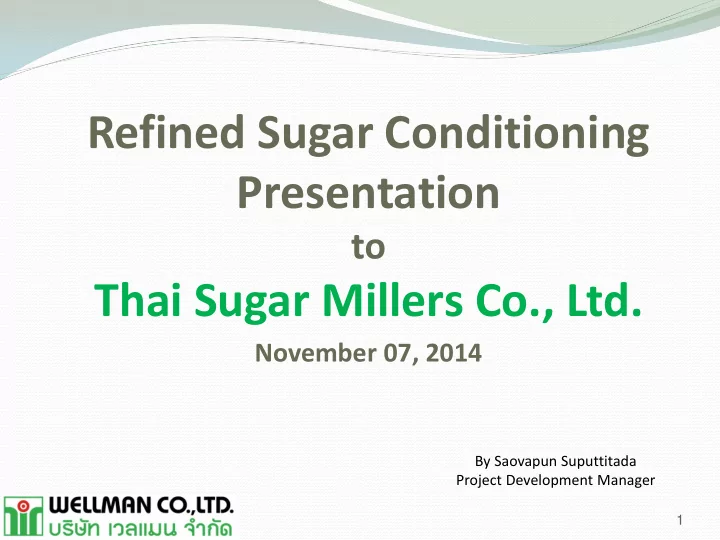

Refined Sugar Conditioning Presentation to Thai Sugar Millers Co., Ltd. 0 November 07, 2014 By Saovapun Suputtitada Project Development Manager 1
Why is it important? If sugar is not conditioned, it can lead to caking- sometimes very severe caking. Just ask this guy jack- hammering out a 90 tonne sugar lump from a silo in Australia!! 2
What Happens When Sugar Cakes? 3
What Makes Sugar Caking? 1. Defects of Sugar : Twins, Conglomerated-agglomerated, Abrasion, Breakage Formation of Twins at high supersaturation in presence - of impurities Twins Twins 4
What Makes Sugar Caking? (Continued) 5
What Makes Sugar Caking? (Continued) 6
What Makes Sugar Caking? (Continued) 2. Dust formation during Drying, Screening Dust & Broken crystals are more active in water adsorption than separated mono crystals. 7
What Makes Sugar Caking ? (Continued) 3. Fine Sugar: Has more surface area and therefore greater propensity to cake. 4. Large CV: Packs more effectively leading to stronger caking. 5. Sugar dried too fast: Increases thickness of the supersaturated film. 6. Big swings in temperature: Encourages moisture migration which exacerbates the problem. 7. Compression in Tall Silo: Forces crystals together more tightly. 8. Vibration in transport: Forces crystals together more tightly. 8
Water Adsorption Lumping and Caking 9
Water Adsorption Lumping and Caking (Continued) 10
Water Adsorption Lumping and Caking (Continued) 11
Water Adsorption Lumping and Caking (Continued) 12
Water Adsorption Lumping and Caking (Continued) 13
Sorption Isotherms of White Sugar in Different Temperatures - For prediction of sugar stability over time in different storage condition 14
Crystal Size Distribution and Water Vapor Sorption 15
Types of Refined Sugar Moisture 1. Inherent Moisture (trapped in crystal structure during crystallization in Pan) 2. Free Moisture (Thin Film carried from centrifugal & removed in Dryers) 3. Bound Moisture (trapped underneath the amorphous shell due to rapid drying) 16
Inherent Moisture is almost constant and surface moisture increases with increased water activity 17
What Does Sugar Conditioning Mean ? The definiton is: Conditioning is the controlled crystallization of the supersaturated film around each sugar crystal so it is in a stable state of which Bound Moisture will not evaporate and migrate. Then sugar will not cake or harden in storage & transportation. Important: It is NOT simply water removal, though sugar conditioning is normally associated with a small reduction in moisture content. 18
How to Condition Sugar? All of these steps contribute…….. Pan Stage: Low CV, limited inclusions Centrifuges: Even quality, no wet lumps Drying: Slow drying, avoid hot sugar Conditioning: The final step Notes: First two are just good refinery practice. The influence of drying method is rarely recognised. Conditioning is poorly understood. If the first steps are done poorly, then there is more work required in conditioning the sugar. 19
Water In and Around Sugar Crystal Crysta l Inherent Moisture only 20
A portion of crystal surface undergoing conditioning Crysta l Inherent Moisture only 21
Refined Sugar Conditioning Four processes take place during conditioning : 1. Crystallisation of sucrose molecules out of the supersaturated surface film. 2. Evaporation of moisture at the interface between the film and the amorphous shell. 3. Vapour-phase diffusion of the moisture across the amorphous layer. 4. Diffusion/convection of the moisture into the bulk interstitial air. The process 3 serves to determine the overall rate of conditioning. 22
Rate of Moisture Reduction during Conditioning Where : M = Mass of Moisture in Film t = Conditioning Time D = Diffusivity of Water Evaporated (m 2 /s) = Density of Air A = Crystal Area Y e = Mass Fraction of Moisture at Equilibrium Y b = Mass Fraction of Moisture in Bulk Air Z = Thickness of layer 23
Parameters which affect conditionability. 1. Initial moisture (%) of sugar crystal. 2. Thickness of the amorphous layer, the nature of the amorphous layer and crystalline sub-layer. 3. Size of crystal (MA) and Coef. of Variation (CV) 4. Conditioning Air Flow Rate 5. Relative Humidity 6. Conditioning Temperature 7. Conditioning Time 24
Conditioning curves - fitted vs actual. 25
Conditioning System A Conditioning system typically requires : An Air Dehumidification system Air Blowers Storage Silos Dust Extraction/ Collection (or Scrubbing) system Upstream and Downstream Conveying systems PLC Control system for automation of process 26
Air Conditioning Plant 27
Good Design of Conditioning Silo Ensure the feed-in sugar evenly distribution inside the Silo; Ensure the First-in First-out System for sugar tracability, and no dead zone; Maintain sugar in the silo for conditioning at least 48 – 60 hrs; Keep sugar moving and continuous flow of sugar discharged from the silo with control-valve; Evenly distribution of Conditioning Air; To protect the silo with Explosion Vent and Vacuum Breaker. 28
Bosch Projects’ Conditioning Silo 29
Conditioning Silo System 30
Performance Guarantee of Conditioning Silo The sugar discharged from the conditioning silos have the following quality: Grade of Sugar Max. moisture content Super Refined Sugar or Refined Sugar 0.04% The moisture content is determined by the Karl Fischer Method This above is subjected to the following conditions of sugar entering the silo, and discharging from the silo bottom continuously. • Colour of sugar not to exceed 20 ICUMSA • Moisture of sugar not greater than 0.03% when determined by oven drying, or 0.08% when determined by Karl Fischer Method • Coefficient of variation < 25 • Mean Aperture 0.4 mm. – 0.6 mm. 31
BOSCH Projects’ Conditioning Silo Reference 32
Bosch Projects’ Conditioning Silo in South Africa 33
Bosch Projects’ Conditioning Silo at MPV in Thailand 34
Bosch Projects’ Conditioning Silo at MPV in Thailand (Continued) 35
Bosch Projects’ Air Conditioning Plant 36
Bosch Projects’ Air Conditioning Plant (Continued) 37
Recommend
More recommend